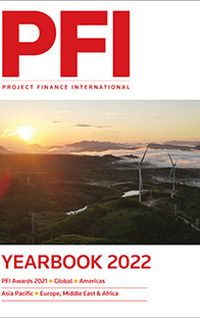2021 saw a greater deployment for lithium-ion energy storage than all previous years combined, with the project finance bank and bond markets starting to coalesce around increasingly standardised deal structures. By Bhuvan Jain, director, Infrastructure & Energy Finance Americas, Natixis.
The US market has seen sporadic financing activity for battery energy storage systems (BESSs) for almost half a decade. However, until now, a mass adaptation of the kind seen in wind and solar sectors has remained elusive. But the frenetic pace of this year’s deal activity in storage or solar plus storage – at Natixis, we closed over US$1.3bn in US project finance debt in the sector this year – delivers definitive confirmation that storage as a sector has arrived as a readily financeable asset class. In MWh terms, this year’s expected deployment of is more than two times in excess of the sum of all previously installed storage capacity since 20121. This push has been led by states such as California, where storage will be instrumental in helping reconcile ambitious Renewable Portfolio Standards (RPS) goals with resource adequacy requirements, and Hawaii, where solar plus storage provides a particularly compelling economic thesis compared with alternatives.
This "moment in the sun" for the storage industry can be attributed to a number of factors. The availability of a federal Investment tax credit for solar plus storage assets helps provide firm renewable power at cost-effective rates. Such transactions include Goldman Sachs Renewable Partners’ Slate Project, Clearway’s Mililani I and Waiawa projects in Hawaii and Daggett 3 Project in California. Several more are expected to follow, across bank and US private placement markets.
Another important factor has been the emergence of Giga-factories with large-scale battery production capacity that has facilitated significant reductions in the marginal cost of battery cells. The stationary energy storage industry has also been able to leverage “learning by doing” improvements informed by wide-scale deployment of batteries in electric vehicles. Finally, project finance markets have proven to be a highly receptive and liquid source of capital, facilitated by innovative structuring around uncertainties such as asset life, degradation, and long-term energy price risk.
A broad cross-section of forecasters all agree that the trend will become more pronounced over time. S&P Global Platts Analytics expects the US storage market to increase 9x through to 2023 with cumulative deployment approaching 10GW by 20242; the Energy Information Administration (EIA) expects about 12GW by 20233, while Wood Mackenzie Power and the Energy Storage Association’s joint report estimates 8GW (26.8GWh)4 by 2024.
Li-Ion chemistries dominate
The current BESS market is dominated by lithium-ion chemistries, and in particular the lithium iron phosphate (LFP), lithium nickel manganese cobalt (NMC) and lithium nickel cobalt aluminum oxide (NCA) chemistries. Through 2020 and 2021, this trend has more definitively shifted to LFP chemistry that does not use cobalt. Battery manufacturers have sought to reduce the use of cobalt due to concerns about an over-reliance on the Democratic Republic of Congo, which ships over 70% of the world’s cobalt supplies5. Technological improvements in these dominant chemistries have continued unabated, with increased energy densities, decreased raw resource use and cell weights, and lengthening battery life.
Although Li-ion batteries are the market standard, several other technologies may become mainstream in the future. Among these are flow batteries, well-suited for long-duration storage, and solid state batteries, higher energy density and faster charging time. Another source of grid stability could be hydrogen, a sub-sector that has attracted significant market attention. Hydrogen has the ability to provide storage capabilities across seasons, charging during summer and discharging in winter when demand for heating picks up. These are all promising new technologies, but lithium ion is the current market standard. It is now well understood by the financing community, benefits from operating data from the first li-ion storage projects that are now four-plus years old and has also been widely deployed in the EV market, which is significantly larger in size than stationary energy storage.
Even so, the typical in Lithium Ion BESS is a bit harder to point to compared with standardised renewable energy technologies such as wind and solar. This is due to variations within the Li-Ion battery space depending on the type of chemistry deployed. Based on what we commonly see for contracts with utility offtakers that use storage to firm renewable capacity, applications are usually for four hours. For developers looking to make a buck by arbitraging off-peak energy at on-peak hours, we see batteries with two-hour applications.
Solar plus storage assets are usually AC-coupled, meaning solar and storage portions are located at separate sites within the project complex, each accompanied by dedicated inverter units. This allows for better control for the BESS regardless of PV production on the given day: ie, batteries can be charged directly by power pulled from the grid beyond the ITC recapture period if allowed by offtake contracts. However, we are now starting to see an increased number of DC-coupled solar plus storage systems where a PV module and BESS are often situated side by side and use the same inverter, thereby reducing the balance of plant costs and losses, but adding complexity in the controls as both assets are limited and controlled by the same inverter.
For lenders, technical due diligence has been focused on the various technical parameters that can affect asset life and degradation, including: the average state of charge, the cell charge and discharge rate (C Rate), throughput or cycling, and temperature. Although important variations exist depending on the battery supplier and the chemistry deployed, generally speaking, higher C-Rate, higher cycling, and higher average state of charge increase degradation, as do unusually hot or cold temperatures that are not well managed by a properly designed, maintained, and operated thermal management system6.
Structuring considerations
Much of the project finance activity for storage or solar plus storage projects in 2021 has been predicated on monetisation of long-term power purchase agreements that provide for availability and capacity based cashflows for 15–20 years. In addition to contracted cashflows, lenders have demonstrated an ability to give credit to merchant cashflows in places such as California, where penetration of intermittent resources has outpaced storage supplies amid ambitious RPS targets – 60% by 2030, 100% by 2045. An oversupply of solar energy has caused increased levels of curtailment and price volatility that solar plus storage is best situated to solve by substituting oversupply during mid-afternoon with extended output stretching beyond the evening hours.
Over the long term, this would help smooth California’s "duck curve", which is characterised by low net load in the mid-afternoon that quickly ramps up by evening. Increased penetration of storage would also help contain curtailment as oversupply from solar in the afternoon can be sent to the batteries instead of the grid. The shift towards storage in California is helped by access to resource adequacy market and a mandate for 1,325MW of solar deployment by 2024.
Monetisation of merchant revenues associated with storage is usually for a limited ~ five-year post-PPA period and at an elevated coverage ratio, compared with contracted cashflows for storage. Coverage ratios for contracted storage are at levels on par with other types of availability based cashflows, such as contracted capacity revenues in a conventional power project. Project financings in the sector are usually supported by a long-term service agreement and warranty packages from battery equipment providers or integrators and an appropriate augmentation programme to buy additional batteries to replace degraded capacity.
Augmentation is particularly important. Over time, battery energy capacities will degrade but the project’s contractual requirements often do not. In order to reconcile these, project developers will put in place a plan to buy additional BESS capacity over time to compensate for degradation, leveraging the modular nature of BESS technology.
By the end of a typical 20 year monetisation period, well over 25% of the BESS capacity is likely to comprise new capacity added after the construction completion date. Given this magnitude of required augmentation, a project’s economics can be sensitive to potential increases in future BESS procurement costs and degradation levels being worse than expected. It is for this reason that lenders thoroughly review a project’s augmentation strategy and require a well thought-out augmentation programme and budget be put in place. The augmentation strategy often includes site and electrical work completed in year 1 to minimise the costs of augmentation later on in the project. This allows the all-in augmentation costs throughout a project life to be reduced relative to a new build project.
Market consensus from several forecasters all point to expectations that future battery prices will follow a "Moore’s law" like trajectory resulting from improved cost efficiencies as production scales up. However, lenders will typically run sensitivities to see the impact on coverage ratios and augmentation reserve in case of procurement of key minerals that are needed for these batteries. Longer-tenor lenders such as bond investors may want to see a dynamic reserve build-up mechanism, with reserving for augmentation costs starting earlier in case battery prices rise or fall slower than expected.
Global market dynamics
The US and China command the bulk of project finance activity in the storage sector. The Biden administration’s Build Back Better legislation, with beneficial provisions such as a 30% investment tax credit for standalone storage, will further turbo-charge this growth if signed into law. This said, our project finance desk colleagues in Latin America, Europe and Asia-Pacific confirm the very global nature of this shift towards storage.
The storage market in Latin America is led by Chile, helped by the inclusion of energy storage in the National and International Public Tender for the Supply of Power and Electric Energy 2021/01, held in September 2021, where a solar plus storage project offered the lowest bid ever recorded and won a 15-year contract with the National Electricity System. The UK is the market leader for storage in Europe, marked by the development of the fast frequency markets and arbitrage models.
In Asia-Pacific, China remains the leader in battery storage, but we have been involved with discussions on storage financing in other geographies, such as Australia, where we are seeing virtual PPA type tolling arrangements being put in place to facilitate financing. In general, gearing on storage transactions outside the US tends to be lower, in the 50%–70% area compared with 80% and higher in the US, where more of the contemplated cashflows are backed by contractual arrangements reliant on availability rather than energy arbitrage.
Footnotes
1 - Wood Mackenzie US Energy Storage Monitor Q3 2021
2 - Going With The Flow: The Competitiveness Of Battery Storage Economics In the Power Sector, S&P Global Ratings, February 2021
3 - Battery Storage in the United States: An Update on Market Trends, EIA August 2021
4 - Wood Mackenzie US Energy Storage Monitor Q3 2021
5 - U.S. Geological Survey, Mineral Commodity Summaries, January 2020
6 - DNV 2020 Battery Performance Scorecard
To see the digital version of this report, please click here
To purchase printed copies or a PDF of this report, please email gloria.balbastro@lseg.com

















